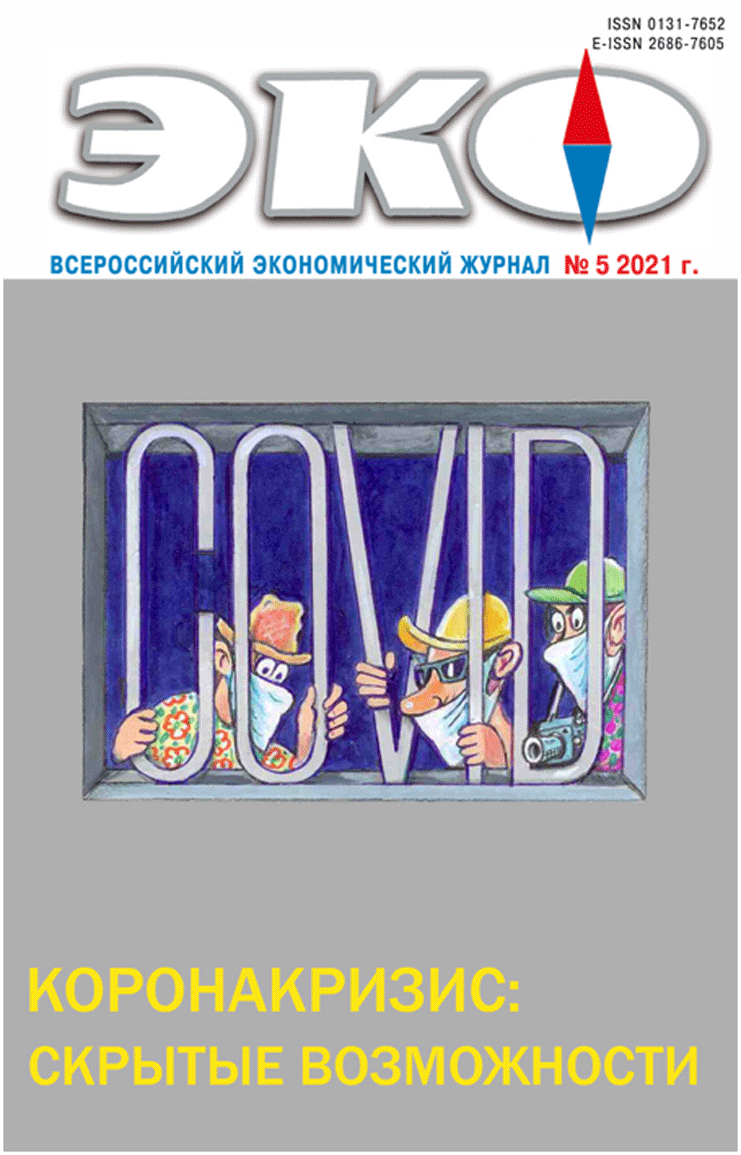MONITORING OF ECONOMIC TRANSFORMATION
The Impact of Institutions for Financial Support of Business Activity on the Regional Investment Potential
Published 2021-05-05
Keywords
- financial institutions,
- spatial development,
- entrepreneurship support,
- investment climate potential,
- investments
- regions ...More
How to Cite
1.
Filatova Н. The Impact of Institutions for Financial Support of Business Activity on the Regional Investment Potential. ECO [Internet]. 2021 May 5 [cited 2025 Dec. 22];51(5):96-117. Available from: https://ecotrends.ru/index.php/eco/article/view/4249
Abstract
The spatial concentration of institutions for financial support of entrepreneurs reflects the business activity in the region. It is a factor affecting the availability of financial resources for investment. The paper explores the relationship of factors of spatial concentration of financial institutions and investment potential in the regions of the Russian Federation. The object of the study is the dynamics of number of financial institutions (regional banks, branches of capital banks in the regions, regional guarantee organizations, regional venture funds), geographically represented in the regions and participating in the financing of investment activities of small and medium-sized enterprises from 2003 to 2019. Correlation-regression analysis made it possible to conclude that positive factors of investment potential are: the number of regional banks and the number of capital banks in the regions. The paper also analyzes modern trends in the development of spatial structure of financial support for entrepreneurship in the Russian Federation, and describes the consequences of its uneven development on the regional economic systems.References
- Агеева С. Д., Мишура А. В. Влияние пространственной концентрации банковского сектора России на кредитование регионов и малого и среднего бизнеса // Вопросы экономики. 2019. № 1. С. 92–108. URL: https://doi.org/10.32609/0042-8736-2019-1-92-108
- Агеева С. Д., Мишура А. В. Институциональные факторы оценки пространственного развития региональных банков //Регион: экономика и социология. 2017а. № 2 (94). С. 52–76.
- Верников А. В., Мамонов М. Е. Долгосрочное банковское кредитование: какие банки им занимаются и почему? // ЭКО. 2016. № 9. С. 135–150.
- Зюзин А. В., Демидова О. А., Долгопятова Т. Г. Локализация и диверсификация российской экономики: региональные и отраслевые особенности // Пространственная экономика. 2020. Т. 16. № 2. С. 39–69. URL: https://dx.doi.org/10.14530/se.2020.2.039–069
- Клишевич Д. С., Панибратов А. Ю. Интернационализация государственных компаний из стран с растущими экономиками: обзор теоретических подходов // Вестник Санкт-Петербургского университета. Менеджмент. 2020. № 19 (2). С. 227–255. URL: http://doi.org/10.21638/11701/spbu08.2020.205
- Коломак Е. А. Пространственное развитие регионов России в XXI в.// Пространственная экономика. 2019. Т. 15. № 4. С. 85–106. URL: https://dx.doi.org/10.14530/se.2019.4.085–106
- Кравченко Н. А., Агеева С. Д. Диверсификация экономики: институциональные аспекты// Journal of Institutional Studies. 2017. Т. 9. № 4. С. 52–67. URL: https://doi.org/10.17835/2076–6297.2017.9.4.052–067
- Мядзелец А. В., Черкашин А. К. Пространственные и временные индикаторы для сравнения условий развития экономики регионов России // Региональные исследования. 2016. № 3. С. 22–31.
- Пахалов А. М. Региональный инвестиционный стандарт как институциональный инструмент улучшения инвестиционного климата в регионах России// Регион: Экономика и Социология. 2019. № 2 (102). С. 246–269. URL: http://doi.org/10.15372/REG20190211
- Сангинова Л. Д. Государственные гарантии при реализации инвестиционных проектов как инструмент обеспечения экономического роста: зарубежный и отечественный опыт// Экономика. Налоги. Право. 2017. Т. 10. № 1. С. 83–90.
- Якунин С. В. Доминирование банков с государственным участием в России: современные тенденции// Научно-исследовательский финансовый институт. Финансовый журнал. 2019. № 3. С. 64–74. URL: http: // doi.org/10.31107/2075–1990–2019–3–64–74
- Balasubramanyan, L., Berger, A., Koepke, M. How do lead banks use their private information about loan quality in the syndicated loan market? Working Papers Federal Reserve Bank of Cleveland. 2017. Vol.16–16R. 48p.
- Berger, A. N., Udell, G. F. A more complete conceptual framework for SME finance. Journal of Banking & Finance. 2006. Vol. 30(11). Pp. 2945–2966.
- Cornaggia, J. et al. Does banking competition affect innovation? Journal of Financial Economics. 2015. Vol. 115. Pp.189–209.
- Davydov, D. Does state ownership of banks matter? Journal of Emerging Market Finance. 2018. Vol. 17(2). Pp.250–285.
- Flögel, F. Distance and modern banks’ lending to SMEs: ethnographic insights from a comparison of regional and large banks in Germany. Journal of Economic Geography. 2017. Vol. 18 (1). Pp. 1–23. URL: http: // doi.org/10.1093/jeg/lbx017
- Klagge, B., Martin, R., Sunley, P. The spatial structure of the financial system and the funding of regional business: a comparison of Britain and Germany. Handbook of Geographies of Money and Finance. 2017. Elgar Publisher, Cheltenam. Chapter 7. Pp. 125–155. URL: https://doi.org/10.4337/9781784719005.00014
- Lee, N., Brown, R. Innovation, SMEs and the liability of distance: the demand and supply of bank funding in peripheral UK regions. Journal of Economic Geography. 2017. Vol.17 (1). Pp. 233–260.
- Lee, N., Luca, D. The big-city bias in access to finance: evidence from firm perceptions in almost 100 countries. Journal of Economic Geography. 2019. Vol.19 (1). Pp. 199–224. URL: https://doi.org/10.1093/jeg/lbx047
- Nogueira, M., Crocco, M., Figueiredo, A. T., Diniz, G. Financial hierarchy and banking strategies: a regional analysis for the Brazilian case. Cambridge Journal of Economics. 2015. Vol. 39(1). Pp. 139–156.
- Filomeni, S., Udell, G.F., Zazzaro, A. Hardening soft information: how far has technology taken us? Money and Finance Research group Working Papers. 2016. 121 p.
- Udell, G. F. SME access to intermediated credit: what do we know, and what don’t we know? Reserve Bank of Australia Conference Volume. 2015. Pp.61–109.

